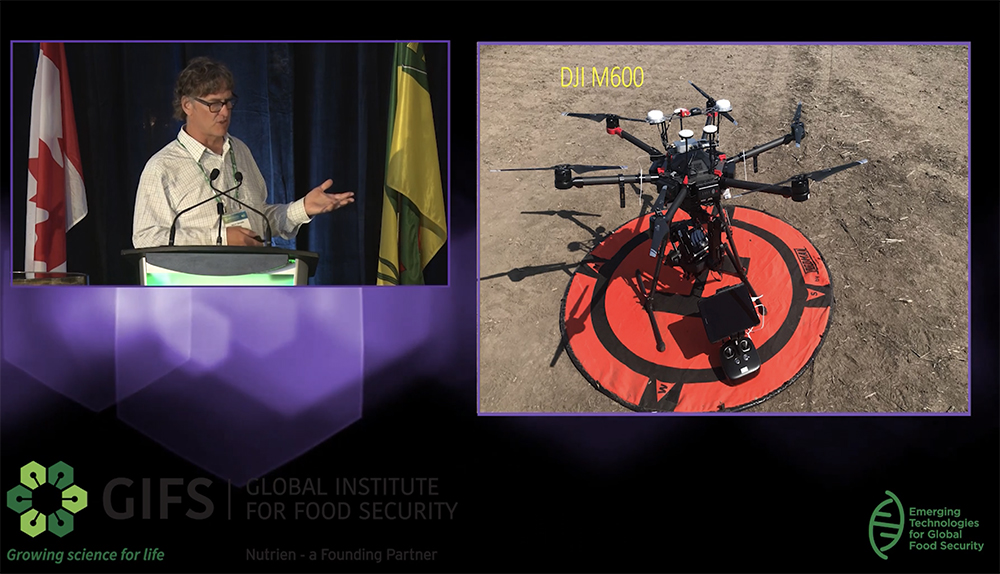An eye in the sky helps understand compounding corruption on the ground when it comes to multiple issues occuring
A master’s student at the University of Saskatchewan developed a study to see if images from an unmanned aerial vehicle can be used to phenotype the phytotoxicity of lentil varieties.
Phytotoxicity is a toxic effect by a compound on plant growth, including by herbicides.
Brianna Zoerb said she wanted to look for another way to select for lentil genotypes with a natural ability or tolerance to survive damage by herbicides that are already on the market.
“We wanted to find out if there was a way to speed up this selection process for new genotypes, instead of waiting for new herbicides to reach consumers,” Zoerb said during a presentation at the University of Saskatchewan’s annual Soils and Crops workshop that was held online this year.
Read Also

Farming Smarter receives financial boost from Alberta government for potato research
Farming Smarter near Lethbridge got a boost to its research equipment, thanks to the Alberta government’s increase in funding for research associations.
She said the visual assessment of herbicide safety and phytotoxicity in crops can be a tedious and bias associated process.
“They’re prone to human error. It comes down to who’s conducting the ratings, the time of day, the direction of the sun, those sorts of things. So, we wanted to see if we could phenotype this or describe these differences in the lentils using imagery.”
The study was run under the direction of Dr. Steve Shirtliffe, and its hypothesis was that UAV hyperspectral imagery is a useful tool in phenotyping herbicide damage in lentils compared to in-person visual ratings.
It had two main objectives: to see if it’s possible to phenotype or describe lentil phytotoxicity using UAV hyperspectral imagery, and to find the vegetation indices that are the most useful in assessing phytotoxicity from herbicide damage.
The trials were set up as a two-factor randomized complete block design with herbicide rate and lentil varieties as the factors, and took place at the University of Saskatchewan in 2019 and 2020.
CDC Greenstar, CDC Maxim, CDC Impala and CDC Improve were the lentil varieties used, while rates of saflufenacil (Heat LQ) and metribuzin (Sencor) herbicides were varied from the recommended dose to up to 10 times recommended rates.
UAV hyperspectral imagery was captured six, 16 and 23 days after the application of metribuzin in accordance with visual ratings for phytotoxicity.
A DJI Matrice 600 Pro UAV with the hyperspectral camera mounted to its gimbal was used.
“We flew the trial at set timings following herbicide application and then the images were pre-processed and spectrally calibrated for cloud cover using a calibration target in the field as well as radiometrically corrected,” Zoerb said.
“Next, using a program called SpectrononPro, spectrally similar pixels were selected for each individual plot. And this was done by creating a cube from selection and then the mean spectrum was graphed for the plot.”
The final step was copying the large data sets into Microsoft Excel where it could be dealt with further.
She said the greatest spectral variation, or these distances between the spectral curves depending on the rate of herbicide applied, was greatest with the date furthest from applications.
In 2019, it was 23 days after the application of metribuzin.
However, researchers did not see the same variations between doses for saflufenacil.
“This kind of made sense with how the herbicides work because saflufenacil is applied pre-emergence. The goal is that the weeds, or the lentils in this case because we’re trying to test them at different rates, they will die before emergence and kind of the resulting effect is more a measure of green cover in the plot and whether the plant grew through the herbicide or not,” Zoerb said.
She said because metribuzin is post emergence, more variation in the dying off the plants at the different rates was observed in the study.
“We could see that as the herbicide (metribuzin) rate increased from the untreated check all the way up to 2,000 grams active which was 10 times the recommended rate, there’s a really big change in the curve especially in the near infrared region,” Zoerb said.
In 2020, the study went up to 20 times the recommended rate of metribuzin and captured images up to 25 days after treatment, where the largest variations between the different rates of herbicides was observed.
Both biomass and visual damage ratings were done in the field and compared with the hyperspectral imagery data from across the treatments, and linear regressions were run and vegetation indices were calculated.
“We’re seeing really strong correlations between NDVI (normalized difference vegetation index) and biomass, as well as NDVI and the visual ratings,” Zoerb said.
She said the greatest variations in the spectral curves occurred in the metribuzin study, and the changes occurred in the green peak, red edge and in near-infrared regions of the graph.
“We are seeing strong relationships between the vegetation indices calculated and visual ratings for quantifying phytotoxicity. Hyperspectral analysis seems to be a useful tool for looking at herbicide phytotoxicity.”


















